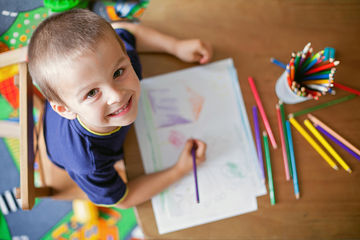Children naturally love art – painting, drawing, making music, the theater. Unfortunately, when schools cut back on budgets, the arts are usually the first to go. It seems that schools do not appreciate the importance of art in building a kid’s brain.
Physiologically, the human brain consists of 2 parts, the left and the right hemisphere. The left brain is used in logical thinking and analytical processes. This is typically what is trained in school work that consists of math, reading and science. The right brain is used in emotional perception, intuition and creativity. It is the right brain that is mainly used when a person is involved in creative endeavors such as making art. It is this part of the brain that typical school environment neglects to train.
It is shown that when gifted kids solve problems in their areas of giftedness, there is increased electrical activity in both hemispheres. It appears that for the brain to be efficient, the two hemispheres of the brains must work together. By stimulating and exercising the right hemisphere of the brain, the arts strengthen the connection between the hemispheres. Kids should be exposed to the arts as their cognitive skills mature so that their right brain will be as developed as the left, and both hemispheres work in tandem, thus achieving the full potential of the mind.
Aside from the physiological effects, the New York Center for Arts Education also lists other benefits of exposing children to art:
- Your kid learns to think creatively, with an open mind
- Your kid learns to observe and describe, analyze and interpret
- Your kid learns to express feelings, with or without words.
- Your kid practices problem-solving skills, critical-thinking skills, dance, music, theater and art-making skills, language and vocabulary of the arts
- Your kid discovers that there is more than one right answer, multiple points of view
- School can be fun – playing can be learning
- Your kid learns to collaborate with other children and with adults
- Arts introduce children to cultures from around the world
- Your kid can blossom and excel in the arts. Even with physical, emotional or learning challenges, can experience success in the arts.
- Arts build confidence. Because there is not just one right way to make art, every child can feel pride in his or her original artistic creations.
- Arts build community. Schools with a variety of differences can celebrate the arts as one community.
According to Kimberly Sheridan, Ed.D., coauthor of Studio Thinking: The Real Benefits of Visual Arts Education, “It’s not as easy to test the skills that children learn from the arts, but that doesn’t make them any less important”. She noted though that participating in a school arts program increases a child’s ability to:
- Observe the world carefully and discard preconceptions in order to envision something and then create it
- Go beyond just learning a skill to express a personal voice
- Problem-solve and persist despite frustration and setbacks
- Reflect on the results and ask what could improve them
Researchers from the Michigan State University have found a very strong correlation between childhood engagement in the creative arts and measurable success later in life. Children who were exposed to a wide variety of arts and crafts were more likely to create unique inventions that is worthy of patents, come up with ideas good enough to start a new company, or publish provocative papers on science and technology. The researchers suggest that children exposed to arts and crafts are able to think “out of the box” since a lot of working with hands involve figuring out how to solve problems creatively. After studying many scientists Co-authors Robert and Michele Root-Bernstein reached this conclusion: “The most eminent and innovative among them are significantly more likely to engage in arts and crafts avocations” than the average Joe.
Arts education and appreciation were also found to have benefits on young people’s brains. In a study by researchers from University of Kansas, students who were selected to visit a museum shows stronger critical thinking skills, displayed higher levels of social tolerance, exhibited greater historical empathy and developed a taste for art museums and cultural institutions.
Also, exposure to arts and the humanities is one important way to foster creativity in children.
The following are tips to make the arts a part of your kid’s development:
Always make arts and crafts supply available and accessible to your kid – paper, pencil, crayons, etc.
Celebrate your child’s artwork – hang their drawings on the wall or save it in a folder. That way, your child feels that her creation is important.
Read books – Ask the librarian at your school or public library to suggest books about artists and the arts.
Notice the arts all around you – take your family to museums, concerts, or theater. Notice the art even in the parks, subways, and open spaces. Start a conversation about what you see.
Enjoy the arts at home – share your artistic skills and interests with your kid. Find out what your kids love about the art.
If your kid shows great interest, enroll her in arts class.
If possible, remind your kid’s school authorities about the importance of art in her education.
Expand your child’s horizon by getting her interested in other art forms including literature, dance and music. See the many benefits of music education for children

